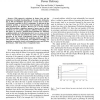89 search results - page 9 / 18 » Moore's Law is Unconstitutional |
CCR
2004
13 years 7 months ago
2004
As the Internet grows in size, it becomes crucial to understand how the speeds of links in the network must improve in order to sustain the pressure of new end-nodes being added e...
JETC
2008
13 years 6 months ago
2008
With aggressive reductions in feature sizes and the integration of multiple functionalities on the same die, bottlenecks due to I/O pin limitations have become a severe issue in to...
TC
2010
13 years 6 months ago
2010
—The number of CPUs in chip multiprocessors is growing at the Moore’s Law rate, due to continued technology advances. However, new technologies pose serious reliability challen...
IPPS
2010
IEEE
13 years 5 months ago
2010
IEEE
With the shrinking of transistors continuing to follow Moore's Law and the non-scalability of conventional outof-order processors, multi-core systems are becoming the design ...
ISCA
2011
IEEE
12 years 11 months ago
2011
IEEE
Since 2005, processor designers have increased core counts to exploit Moore’s Law scaling, rather than focusing on single-core performance. The failure of Dennard scaling, to wh...

